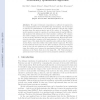Free Online Productivity Tools
i2Speak
i2Symbol
i2OCR
iTex2Img
iWeb2Print
iWeb2Shot
i2Type
iPdf2Split
iPdf2Merge
i2Bopomofo
i2Arabic
i2Style
i2Image
i2PDF
iLatex2Rtf
Sci2ools
EVOW
2009
Springer
2009
Springer
Validation of a Morphogenesis Model of Drosophila Early Development by a Multi-objective Evolutionary Optimization Algorithm
We apply evolutionary computation to calibrate the parameters of a morphogenesis model of Drosophila early development. The model aims to describe the establishment of the steady gradients of Bicoid and Caudal proteins along the antero-posterior axis of the embryo of Drosophila. The model equations consist of a system of non-linear parabolic partial differential equations with initial and zero flux boundary conditions. We compare the results of single- and multi-objective variants of the CMA-ES algorithm for the model the calibration with the experimental data. Whereas the multiobjective algorithm computes a full approximation of the Pareto front, repeated runs of the single-objective algorithm give solutions that dominate (in the Pareto sense) the results of the multi-objective approach. We retain as best solutions those found by the latter technique. From the biological point of view, all such solutions are all equally acceptable, and for our test cases, the relative error between ...
| Added | 19 May 2010 |
| Updated | 19 May 2010 |
| Type | Conference |
| Year | 2009 |
| Where | EVOW |
| Authors | Rui Dilão, Daniele Muraro, Miguel Nicolau, Marc Schoenauer |
Comments (0)

